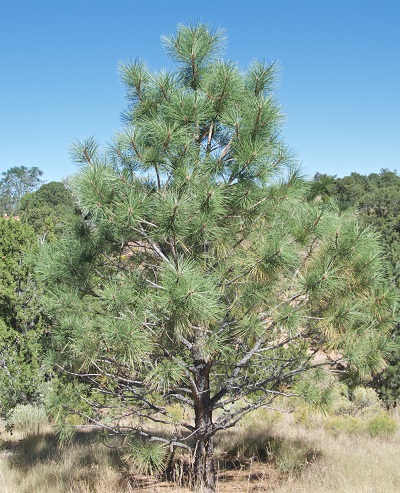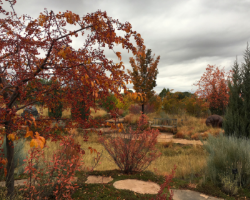November 2019
By Scott Canning, Director of Horticulture and Special Projects
I looked back at my November Garden Chores from last year, and I covered just about everything. This year, after a record-warm September, we flipped into an October of extremes, especially record-cold mornings. I should have taken my November chores to heart in late October! I have tucked all my tender plants away, but I have yet to dig my dahlias or glads. Luckily, the ground is a great heat reservoir, so I probably avoided losing them if I act quickly now that their tops are frosted dead. See below for storage tips.

Ponderosa pine (photo by Janice Tucker)
Many nurseries are holding end-of-season sales on big woody plants, and the savings can be considerable. November is still a good time to plant or transplant deciduous trees and shrubs. It is getting late to transplant conifers, because they continue to transpire (loose water from their needles) through the winter and suffer from the root-pruning that invariable accompanies digging. They can, however, still be planted out from containers, and you can even still plant balled and burlapped conifers IF they haven’t been dug recently and look robust. Unlike conifers, deciduous trees and shrubs give you a longer window because they lose their leaves and transpire very little from their trunks and twigs. They will grow roots as long as the soil remains above 45F, and again in the spring before they leaf out, to make up for roots lost when they were dug. I know, it is NOT a hard-and-fast rule, but if you think about water lost through needles throughout the winter versus water not lost by trees that drop their leaves, I hope it begins to make sense.
Protect your trees, especially young ones, by removing grass and weeds from their base where rodents might feed on young bark and in winter. Consider hardware cloth collars—they will protect young trees even if there is snow that might hide the enemy: Rodents don’t truly hibernate and love trench warfare in winter. Also consider propping any small weeping trees with some extra staking to avoid breakage in case of that rare, heavy wet snow. Even though I recently sprayed my young fruit trees with deer repellant, they got browsed! Mechanical barriers are superior, if possible rely on them!
In the flower garden, it is time to dig and store dahlias, gladiolus, and other tender bulbs you may have planted in spring. They can be stored in a box of barely damp material in a cool but not freezing location (storage material can be crushed leaves, ambrosia or other wood shavings- peat moss was traditionally used but its mining is unsustainable). Too much moisture invites rot; too little risks desiccation, so check on them once in a while through the winter. It is also last-call for fall-planted spring-flowering bulbs. You might find great sales at the end of the season. Time, too, to start cleanup, but leave your self-sowers and ornamental grasses standing, as well as any plants that are forage for birds.
 In the vegetable garden, sow a cover crop or a mix of cover crops as you empty the beds. And in a hopeful gesture at this time of year, besides planting bulbs, you can sow a bed of spinach for your earliest crop next year. And continue to compost, compost, and compost some more!
In the vegetable garden, sow a cover crop or a mix of cover crops as you empty the beds. And in a hopeful gesture at this time of year, besides planting bulbs, you can sow a bed of spinach for your earliest crop next year. And continue to compost, compost, and compost some more!
Winterize your irrigation system if you haven’t already. Well-designed systems might have gravity drains; otherwise, you might need to use compressed air or have an irrigation contractor do it. The most vulnerable components are the hard plastic pipes and valves in outside valve boxes. Exposed backflow preventers are vulnerable, too, as I have learned the hard way. Finish up November’s chores, take a deep breath and REST!


